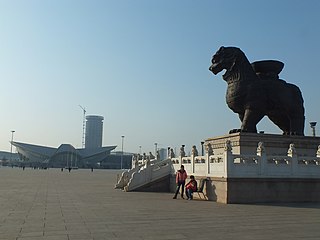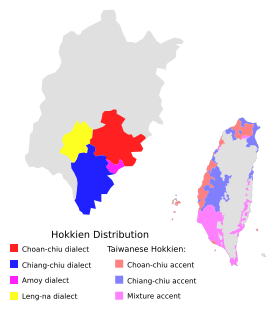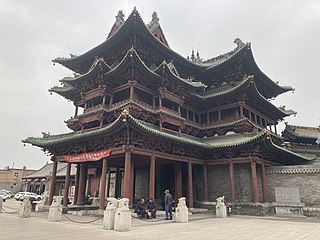Related Research Articles

The Forbidden City is a palace complex in Dongcheng District, Beijing, China, at the center of the Imperial City of Beijing. It is surrounded by numerous opulent imperial gardens and temples including the 22-hectare (54-acre) Zhongshan Park, the sacrificial Imperial Ancestral Temple, the 69-hectare (171-acre) Beihai Park, and the 23-hectare (57-acre) Jingshan Park.

Liaoning, is a coastal province in Northeast China that is the smallest, southernmost, and most populous province in the region. With its capital at Shenyang, it is located on the northern shore of the Yellow Sea, and is the northernmost coastal province of the People's Republic of China.

Qinhuangdao is a port city on the coast of China in northern Hebei. It is administratively a prefecture-level city, about 300 km (190 mi) east of Beijing, on the Bohai Sea, the innermost gulf of the Yellow Sea. Its population during the 2010 national census was 2,987,605, with 1,546,743 people living in the built-up area made up of 4 urban districts.

Beijingxi railway station, colloquially referred to as West Station, is located in western Beijing's Fengtai District. Opened in early 1996 after three years of construction, it was the largest railway station in Asia with an area of 510,000 m2, before being surpassed by Shanghai Hongqiao railway station in platform capacity. The station serves in average 150,000–180,000 passengers per day with a maximum of 400,000 people per day. It was expanded in 2000 and had a large number of parking spaces added.

798 Art Zone, or Dashanzi Art District, is a complex of 50-year-old decommissioned military factory buildings boasting a unique architectural style that houses a thriving artistic community in Dashanzi, Chaoyang District of Beijing. The area is often called the 798 Art District or Factory 798 although technically, Factory #798 is only one of several structures inside the complex formerly known as 718 Joint Factory. The buildings are within alleys number 2 and 4 on Jiǔxiānqiáo Lù (酒仙桥路), south of the Dàshānziqiáo flyover (大山子桥). The area is anchored by the UCCA Center for Contemporary Art, the largest and most visited venue in the area. In recent years, it has been the main venue for the annual Beijing Queer Film Festival and Beijing Design Week.

Cangzhou is a prefecture-level city in eastern Hebei province, People's Republic of China. At the 2010 census, Cangzhou's built-up area made of Yunhe, Xinhua districts and Cang County largely being conurbated had a population of 1,205,814 inhabitants, while the prefecture-level administrative unit in total has a population of 7,134,062. It lies approximately 90 kilometres (56 mi) from the major port city of Tianjin, and 180 km (110 mi) from Beijing.

The Niujie Mosque is the oldest mosque in Beijing, China. It was first built in 996 during the Liao Dynasty and was reconstructed as well as enlarged under the Kangxi Emperor of the Qing Dynasty.

Langfang is a prefecture-level city of Hebei Province, which was known as Tianjin Prefecture until 1973. It was renamed Langfang Prefecture after Tianjin became a municipality and finally upgraded into a prefecture-level city in 1988. Langfang is located approximately midway between Beijing and Tianjin. At the 2010 census, the population of Langfang was 4,358,839, of whom 868,066 lived in the built-up area made of Guangyang and Anci districts; its total area is around 6,417.28 km2 (2,477.73 sq mi). Langfang borders Baoding to the southwest, Cangzhou to the south, Beijing to the north and Tianjin to the east. Sanhe City and Dachang Hui County are now conurbated with Beijing, so that they form part of the same built-up area. Langfang is the smallest prefecture-level city of Hebei Province by land area.

Bügür County, also known from Mandarin Chinese as Luntai County, is a county in central Xinjiang Uyghur Autonomous Region and is under the administration of the Bayin'gholin Mongol Autonomous Prefecture. It contains an area of 14,189 km2 (5,478 sq mi). According to the 2002 census, it has a population of 90,000.
Internal migration in the People's Republic of China is one of the most extensive in the world according to the International Labour Organization. This is because migrants in China are commonly members of a floating population, which refers primarily to migrants in China without local household registration status through the Chinese Hukou system. In general, rural-urban migrant most excluded from local educational resources, citywide social welfare programs and many jobs because of their lack of hukou status. Migrant workers are not necessarily rural workers; they can simply be people living in urban areas with rural household registration.

Huanghua is a county-level city located in the Bohai Gulf coastal region of Hebei province, China. It is under the jurisdiction of the prefecture-level city of Cangzhou.

The Zhangzhou dialects, also rendered Changchew, Chiangchew or Changchow, are a collection of Hokkien dialects spoken in southern Fujian province, centered on the city of Zhangzhou. The Zhangzhou dialect proper is the source of some place names in English, including Amoy, and Quemoy.

Urban Planning in China or The People's Republic of China is currently characterized by a top-down approach, high density urban development and extensive urbanization. China's urban planning philosophies and practices have undergone multiple transitions due to governance and economic structure changes throughout the nation's extensive history. The founding of the People's Republic of China in 1949 marks the beginning of three recent historical stages of urban planning philosophies and practice that represent a divergence from traditional Chinese urban planning morphologies are broadly categorized as socialist, hybrid and global cities.

In the People's Republic of China, the study of sociology has been developing steadily since its reestablishment in 1979. Chinese sociology has a strong focus on applied sociology, and has become an important source of information for Chinese policymakers.

Jiexiu is a county-level city in the central part of Shanxi Province, China. It is under the administration of the prefecture-level city of Jinzhong and is located in the latter's western confines. Notable sites in and around Jiexiu include Mount Mian, Zhangbi Fortress, Houtu Temple and Xianshenlou.

The Daming Palace was the imperial palace complex of the Tang dynasty, located in its capital Chang'an. It served as the imperial residence of the Tang emperors for more than 220 years. Today, it is designated as a national heritage site of China, and part of the UNESCO World Heritage Site "Silk Roads: the Routes Network of Chang'an-Tianshan Corridor". The area is located northeast of present-day Xi'an, Shaanxi Province.
The Hailu dialect, also known as the Hoiluk dialect or Hailu Hakka, is a dialect of Hakka Chinese that originated in Shanwei, Guangdong. It is also the second most common dialect of Hakka spoken in Taiwan.
The Huizhou dialect is a Chinese dialect spoken in and around Huicheng District, the traditional urban centre of Huizhou, Guangdong. The locals also call the dialect Bendihua and distinguish it from the dialect spoken in Meixian and Danshui, Huiyang, which they call Hakka.
A sponge city is a new urban construction model for flood management, strengthening ecological infrastructure and drainage systems, proposed by Chinese researchers in early 2000 and accepted by the Chinese Communist Party (CCP) and the State Council as urbanism policy in 2014. It can alleviate urban flooding, water resources shortage, and the urban heat island effect and improve the ecological environment and biodiversity by absorbing and capturing rain water and utilizing it to reduce floods. Rain water harvested can be repurposed for irrigation and for home use. It is a form of a sustainable drainage system on an urban scale and beyond. Sponge city policies are a set of nature based solutions that use natural landscapes to catch, store and clean water; the concept has been inspired by ancient wisdom of adaptation to climate challenges, particularly in the monsoon world.

Miyun Reservoir is a large-scale reservoir in the People's Republic of China, located 16 kilometers north of the Miyun District in Beijing, straddling the Chaohe River (潮河) and Baihe River (白河). There are two major rivers flowing into the reservoir, namely the Bai River and the Chao River. The reservoir was formally completed on September 1, 1960.
References
- ↑ Zisheng Shao (19 August 2015). The New Urban Area Development: A Case Study in China. Springer. p. 256. ISBN 978-3-662-44958-5.
- ↑ Joseph A. Wilkes (1990). Encyclopedia of architecture: design, engineering & construction. Wiley. p. 352. ISBN 978-0-471-63243-6.
- ↑ "Women in Architecture". China. ARVHA. Archived from the original on 26 March 2012. Retrieved 5 February 2012.